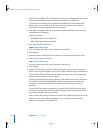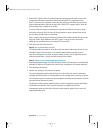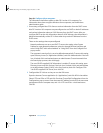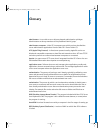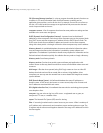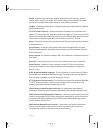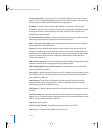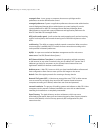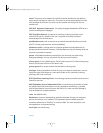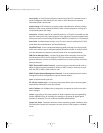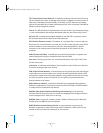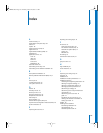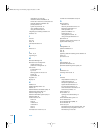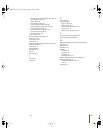
Glossary 133
search policy A list of directory domains searched by a Mac OS X computer when it
needs configuration information; also the order in which domains are searched.
Sometimes called a search path.
shadow image A file, hidden from regular system and application software, used by
NetBoot to write system-related information while a client computer is running off a
server-based system disk image.
share point A folder, hard disk (or hard disk partition), or CD that is accessible over the
network. A share point is the point of access at the top level of a group of shared items.
Share points can be shared using AFP, Windows SMB, NFS (an “export”), or FTP protocols.
short name An abbreviated name for a user. The short name is used by Mac OS X for
home directories, authentication, and email addresses.
Simplified Finder A user environment featuring panels and large icons that provide
novice users with an easy-to-navigate interface. Mounted volumes or media to which
users are allowed access appear on panels instead of on the standard desktop.
SMB (Server Message Block) A protocol that allows client computers to access files
and network services. It can be used over TCP/IP, the Internet, and other network
protocols. Windows services use SMB to provide access to servers, printers, and other
network resources.
SMTP (Simple Mail Transfer Protocol) A protocol used to send and transfer mail. Its
ability to queue incoming messages is limited, so SMTP usually is used only to send
mail, and POP or IMAP is used to receive mail.
SNMP (Simple Network Management Protocol) A set of standard protocols used to
manage and monitor multiplatform computer network devices.
spam Unsolicited email; junk mail.
SSL (Secure Sockets Layer) An Internet protocol that allows you to send encrypted,
authenticated information across the Internet.
static IP address An IP address that is assigned to a computer or device once and is
never changed.
subnet A grouping on the same network of client computers that are organized by
location (different floors of a building, for example) or by usage (all eighth-grade
students, for example). The use of subnets simplifies administration.
System-less clients Computers that do not have operating systems installed on their
local hard disks. System-less computers can start up from a disk image on a NetBoot
server.
LL2343.Book Page 133 Thursday, August 14, 2003 5:12 PM



